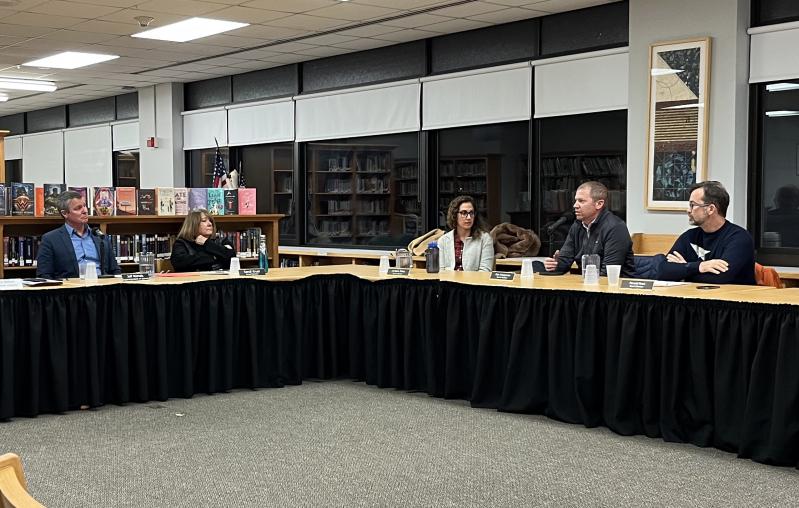Sag Harbor School District officials have decided not to wait for the Southampton Town Board to formally vote on its offer of community preservation fund money before starting what they have been calling “phase two” of the process. On Dec. 21 the district began gathering public comment to shape the proposal for an athletic field and related facilities on Marsden Street, which has been a hot issue in the village ever since the plan — involving the purchase of land from a private developer — was announced in September.
Of note during the question-and-answer forum was a statement made by Chris Tice, a Corcoran real estate agent who was elected to multiple terms on the Sag Harbor School Board, that suggested precious time is ticking away for the town and school district to move forward with the plan.
“This property has a buyer willing to pay more than the school district. . . . I’ve confirmed it for a client, so I know that to be a fact,” Ms. Tice said.
In June, after months of discussions, the Southampton Town Board authorized Lisa Kombrink, who has since retired as community preservation program director, to make an offer to the school district of $6 million to go along with a $2.75 million share from the district to buy four contiguous lots on Marsden Street. On Nov. 3, Sag Harbor voters said yes to spending that money — including an additional $700,000 for the outright purchase of a fifth lot across the street, plus closing costs — with a vote of 638 to 521.
The district has been waiting for the town board to hold the public hearing and formal vote required by law; two town officials told The Star earlier this month that the offer was being reconsidered.
Ms. Tice said it’s a misrepresentation when opponents of the Marsden Street field plan claim the properties will be left “untouched” if the plan is abandoned. There will likely be new homes with “pool houses, separate garages, multiple buildings,” she said.
During the question-and-answer session — for which questions were to be submitted in writing ahead of time — several questions from community members seemed to suggest a general lack of understanding about athletic fields and school sports programs. School officials explained that Pierson Middle and High School has a fraction of the field space that both adjacent and regional secondary schools have for after-school sports. The majority of fall and spring Pierson teams practice and play home games at Mashashimuet Park, with most students walking there after school.
The district pays for yearly use agreements with the park for its facilities, which comes out of school taxes paid by residents. School officials have said that having a field on Marsden Street will not totally eliminate the district’s reliance on the park for certain sports.
Critics brought up the matter of the environmental analysis performed ahead of the Nov. 3 vote, which stated that the purchase of the property would not have an adverse impact on the ecosystem. Saverio Belfiore of H2M, the district’s architectural and engineering firm, explained that the document — completed in accordance with the State Environmental Quality Review Act, or SEQRA — was just the first of two such reviews. A second SEQRA report will need to be done before the development of the property and will be carried out by an independent third party consultant, Mr. Belfiore said.
Another resident questioned why the district needs more field space if school enrollment, which hovers around 1,000 students each year, is not projected to increase. School officials replied by saying that field space is not a new need.
“The premise that flat enrollment means we don’t need more space is a false premise,” Jordana Sobey, a board member, said. “We want to make our school better. Right now, we are making sacrifices in the fall and spring . . . every day. Adding a field helps that situation and makes our school better.”
The dialogue turned to the issue of synthetic turf versus natural grass, which has been a controversial subject in Sag Harbor for several years. School officials continue to say this matter has not yet been decided, but some have argued for artificial turf — on the merits of how versatile such a field could be — and others against it, based on environmental and health concerns over the materials that make up synthetic turf surfaces.
In 2016, a proposal for an artificial turf field behind Pierson failed by a wide margin for the latter reasons. But the natural grass field there that was redone is widely known to be frequently unusable by sports teams because it’s also used by kids in gym classes and at recess.
“It’s imperative that it’s a surface that can sustain a lot of use because the school won’t have 100-percent control over when it’s being used,” Jeff Ziglar, a district parent who also coaches youth sports, suggested during the forum. “It’s going to get used a lot . . . so it should be a surface that should be sustainable.”
The district has repeatedly pledged to be “good neighbors” to those who live on or near Marsden Street.
“We’re not going to want it to be used late into the night . . . and interfere with neighbors’ enjoyability” of their own properties, Jeff Nichols, the district superintendent, said. There will be “reasonable limits in place regarding how those fields or field will be used and to what time in the day.”
School officials urged community members to bring constructive feedback and suggestions to the table.
“Rather than just criticizing . . . bring us your actual concerns so we can be the good neighbors we want to be and address them,” Ms. Sobey said.

